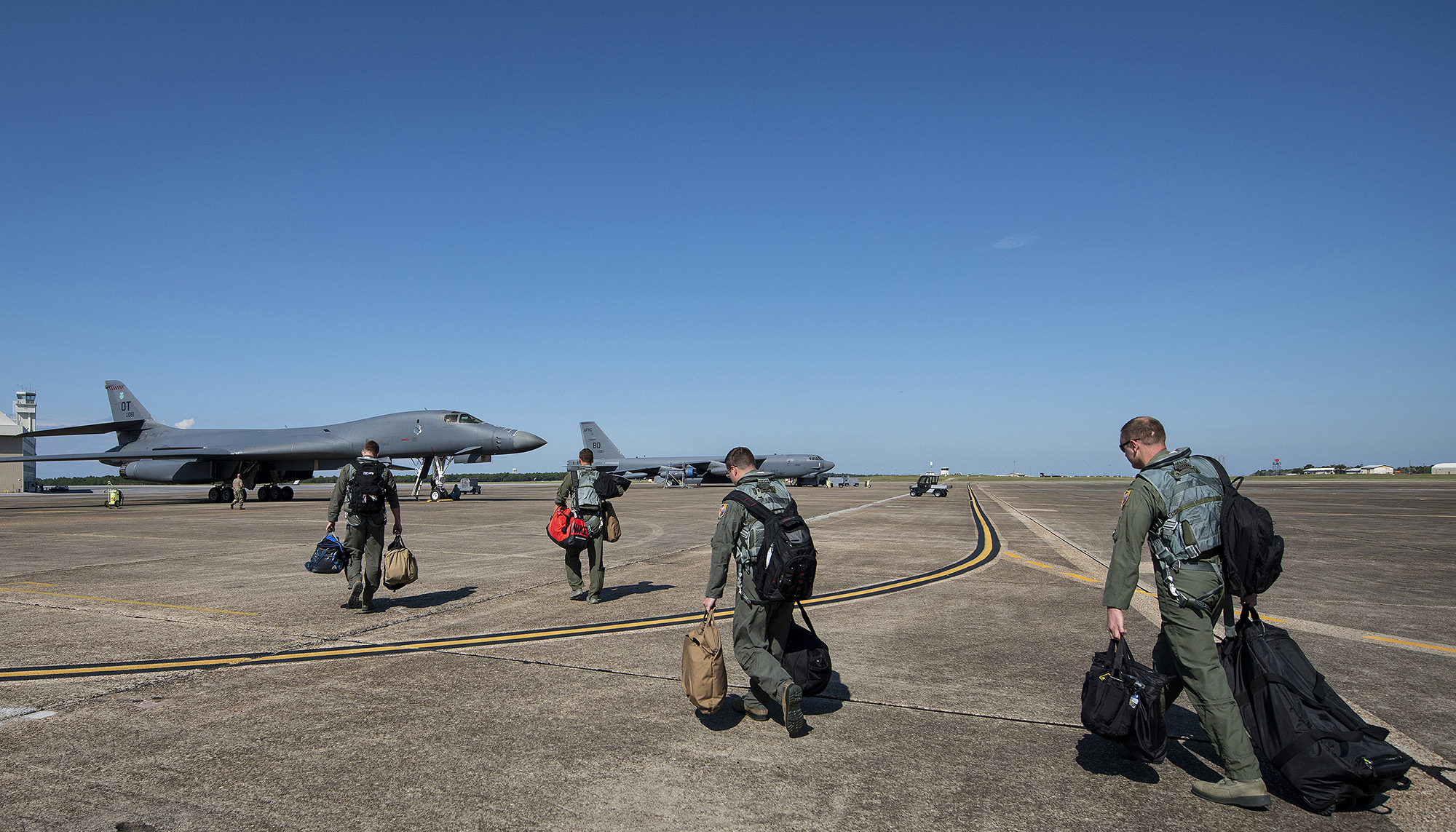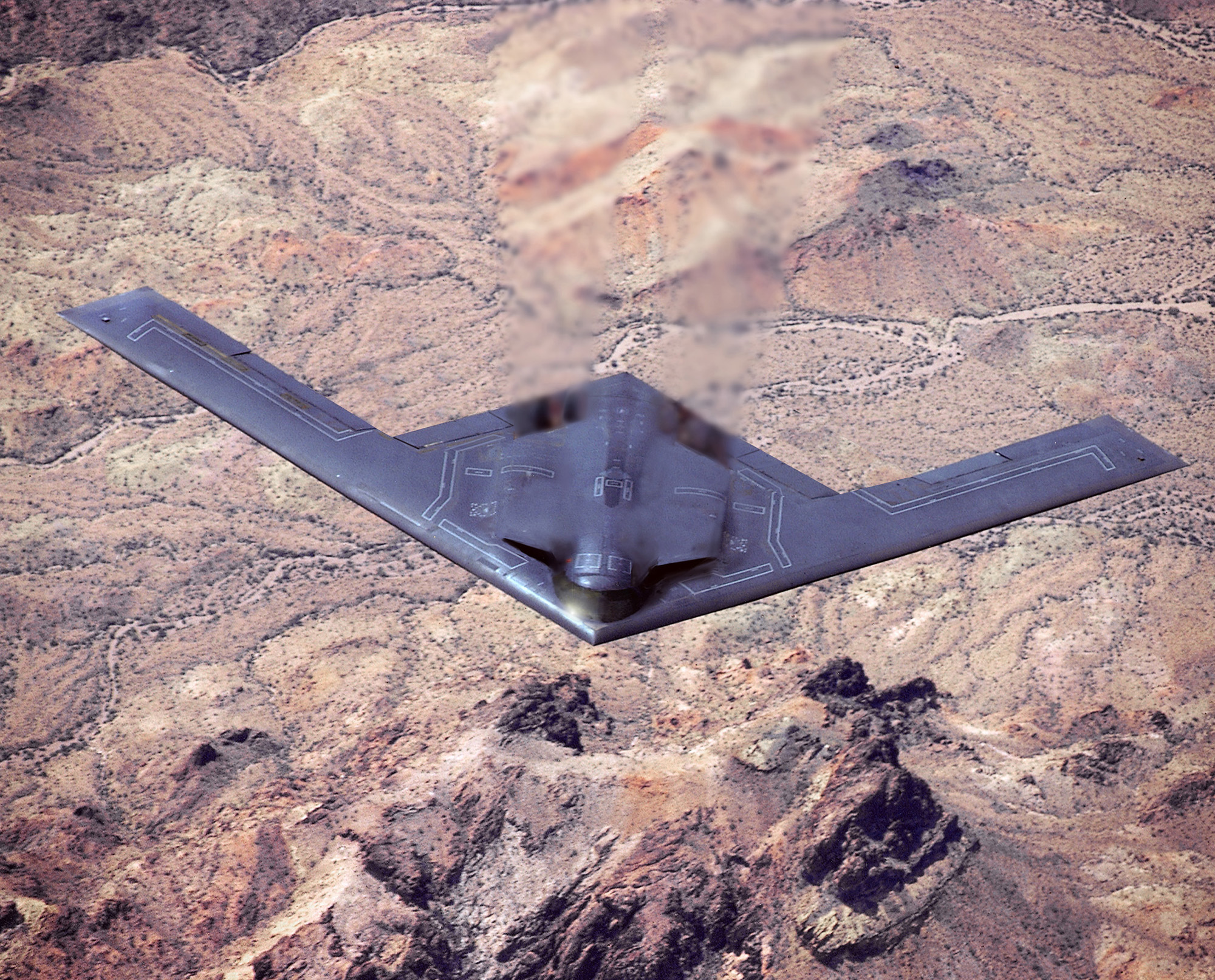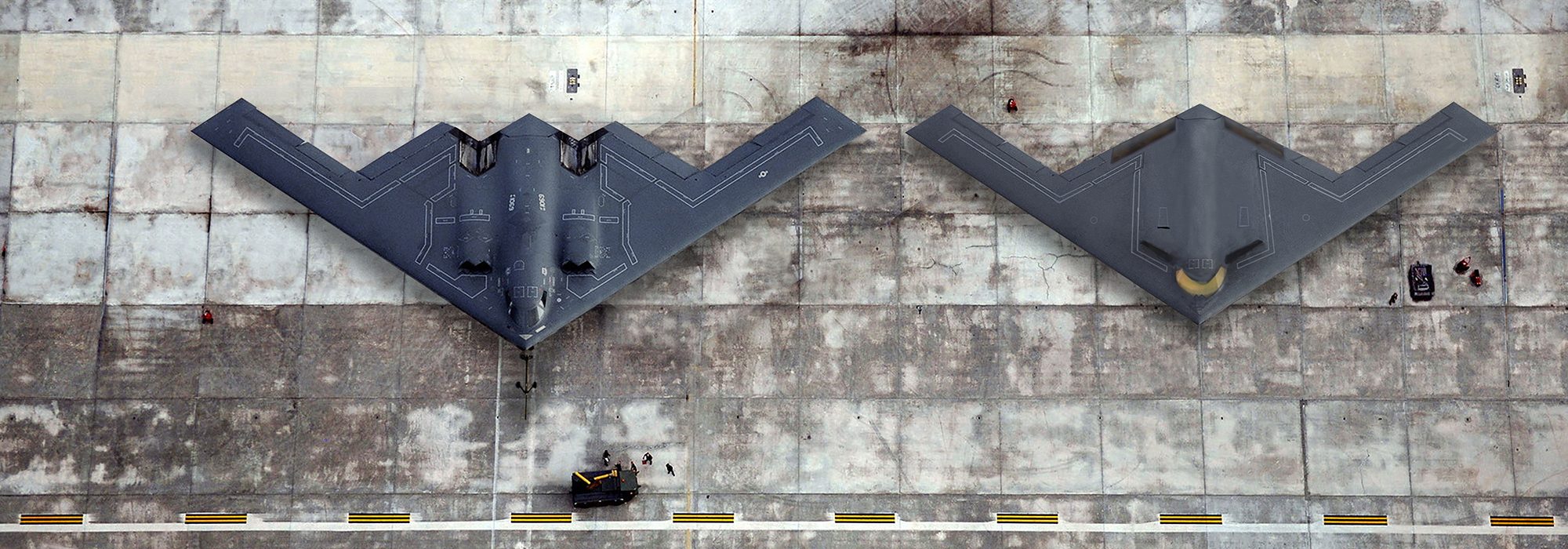Four years into development, the Air Force is starting to reveal more about the B-21 bomber.
The first B-21 Raider bomber is coming together at Northrop Grumman’s Palmdale, Calif., facility and will likely be rolled out for public view in 20 months, making its first flight a few months later. The Air Force is also planning, in its next budget proposal, to increase the buy to 150 or more aircraft, up from 100. The B-21 picture, highly secret for the last four years, is starting to come into focus.
Top Air Force leaders are beginning to speak more openly about the B-21. Randall G. Walden, head of the Air Force Rapid Capabilities Office, which runs the bomber development effort, said in October, “We’re ready to start actually building parts.”
Construction has begun at Northrop Grumman’s Palmdale plant. “We do have an airplane in there,” Walden said. “That would be our test ship No. 1. We’re working the production line, literally, today.” Major structures, like the wings, are being brought into the assembly line.
When it comes to the B-21 Raider, USAF won’t try to ‘sneak it out.’ There will be a public rollout of the new bomber.Randall G. Walden, head of the Air Force Capabilities Office
Timelines at this stage are still slippery. Gen. Stephen W. Wilson, Vice Chief of Staff of the Air Force, said he was counting down the days to the B-21’s first flight, which he projected would come in December 2021.Walden is not so sure. Though that’s still the target, “I would not bet on that date,” he said, emphasizing how “complex” the B-21 is. Integration issues, ground testing, and even weather could affect first flight, he said.
The Air Force won’t try to simply “sneak it out,” Walden asserted, promising a public rollout at Palmdale, just as with the B-2 in 1988. But while it took nine months for the B-2 to go from rollout to inaugural sortie, Air Force officials anticipate a much shorter preflight evaluation period before that first flight from Palmdale to nearby Edwards AFB, Calif. After that, Walden said, USAF will “start to open up” about B-21 capabilities.


At a Palmdale event in August celebrating the 30th anniversary of the B-2, Northrop Grumman said it had grown from 24,000 to about 28,000 employees at its California locations. Aerospace Systems sector President Janis G. Pamiljans said, “We’ve been on a tremendous hiring spree” while simultaneously refurbishing and expanding the Palmdale facilities, which included relocating production operations for the RQ-4 Global Hawk and MQ-4 Triton.
Northrop’s contract for engineering and manufacturing development (including the first five aircraft) represents a $23.5 billion investment. The production contract could be worth $55 billion for 100 airplanes, Walden said in 2016, not including additional, unidentified programs in the “family of systems” that will make the B-21 effective.
The Air Force’s original plan for the B-21 contract called for “80 to 100” aircraft, but USAF leaders over the past two years have been touting “at least 100” airplanes. At AFA’s Air, Space & Cyber Conference in September, USAF Chief of Staff Gen. David L. Goldfein said he’s “100 percent in lockstep” with the views expressed in multiple third-party reports that 100 is too few. While he acknowledged the B-21’s development cycle can’t be sped up, he said he’d like to buy more than 100 of the jets, and buy them faster than currently planned.
Matthew P. Donovan, service undersecretary, in an October interview with Air Force Magazine, laid out the math behind the “Air Force We Need” analysis, which called for seven more bomber squadrons, growth required for long-range power projection in the Pacific Theater and elsewhere. “A bomber squadron’s got about eight airplanes in it,” Donovan noted, so the Air Force’s analysis indicates a requirement for about 56 more bombers. “I think … you’ll see us put some real numbers to the total numbers of bombers” in the 2020 budget request, Donovan said. But he also cited an analysis by the Air Force Association’s Mitchell Institute for Aerospace Studies, which concluded the Air Force has a demand for at least 174 B-21s, noting Goldfein “agrees with that.”
The Air Force has not announced any deviation from original cost targets and cost ceilings on the B-21. In base year 2010 dollars, the service said at contract award that it expected the jets to come in at $511 million apiece, with a not-to-exceed price of $550 million. In 2019 dollars, that would be $553 million and $651.7 million, respectively. Both numbers were calculated against a buy of 100 airplanes, though; a larger volume of production could drive unit costs lower.
Air Force leaders have said numerous times that the B-21 program is among the best-run programs in the Air Force, hitting its cost and schedule marks. Walden said the only thing that could dramatically raise the price of the airplane is a significant change in performance requirements.
USAF’s Global Strike Command plans to retire the 62 B-1 and 20 B-2 bombers by around 2031. Producing 15 B-21s per year would enable the Air Force to have 100 of the new bombers on hand by that point. The Air Force has reactivated the 420th Flight Test Squadron at Edwards—the unit that tested the B-2—to put the B-21 through its paces.
Satellite images of Edwards reveal a number of new structures in the South Base area, including one building that is about 220 feet square—about the size needed to shelter a B-2-sized aircraft. The Air Force has also relocated B-1 and B-52 test activities away from South Base.
Walden told Air Force Magazine that the B-21 program had not made use of a subscale demonstrator to prove out the aircraft’s aerodynamics, although he had previously described wind tunnel testing on the bomber. “You always look for opportunities to do things lower-risk,” he said, but a subscale aircraft was not part of that effort, he said. He declined to offer further details.
Walden’s comment was curious because a number of Air Force officials and members of Congress have made comments suggesting they were satisfied there was a “fly before buy” approach taken with the B-21. In selecting Northrop Grumman as the B-21 contractor, the Air Force cited the company’s competence to do the project based on its “other programs.” Those could include a high-altitude intelligence, surveillance, and reconnaissance aircraft said to be called the RQ-180, which may resemble the B-21’s cranked-kite planform. Northrop’s balance sheet indicates a hefty amount of classified work.
The B-21’s shape, identical to the original planform of the B-2, suggests the aircraft is optimized for stealth at high altitude. The B-2’s requirements were changed early in the program, to give that airplane more rigidity and ease of handling in low-level penetration flight. The B-2’s shape was altered to the now-familiar “sawtooth” tail; a design revision that cost billions of dollars and years of time.
The sole artist’s concept of the B-21 released by the Air Force shows the cranked-kite shape without modification, indicating USAF won’t be taking the B-21 down to fly nap-of-the-earth.

B-21 development has not come without challenges. Rep. Rob Wittman (R-Va.), then head of the House Armed Services Seapower and Projection Forces Subcommittee, cited a dispute between “ducting contractors” and engine maker Pratt & Whitney in March 2018.
Pratt engineers sought to “change some of the cowling,” Wittman suggested, which could affect low-observable characteristics.
The artist’s concept shows the B-21 with very straight and narrow, angled air intakes on the upper fuselage. To maintain stealth, engine fan blades must be hidden inside the fuselage, and the ducting lined with radar-absorbent materials to reduce the radar cross section of the aircraft.
Wittman said the B-21 uses a “very, very different design as far as airflow,” suggesting trade-offs between stealth and thrust were being debated. Meanwhile, other contractors were worried about the exhaust, he said. Without elaborating, Wittman also cited “snags” affecting the B-21’s wings.
Months later, however, Walden said those issues had been resolved.
“Complex weapon systems, especially engine integrations” are challenging, he said. “You’ve got to get [engine] throat sizes done right, prior to anything being built.” The Rapid Capabilities Office got “insight from actual lab testing,” settled on a solution, and component testing was moving ahead at an “appropriate speed.”
Wittman also noted that the B-21 program had created a nonflying “iron bird” shape to test the fit of components. The use of mockups in this fashion is a common step in an aircraft’s development.
Air Force officials, meanwhile, describe B-21 as an “extremely low-observable” design, as opposed to the “very low-observable” F-22 and F-35.
The Air Force has not said if the B-21 will be powered by two or four engines, but the consensus among aerospace analysts is that the jet likely uses Pratt’s F135 engine, which also equips the F-35 fighter. Two F135s could generate 56,000 pounds of dry (non-afterburning) thrust, but would require a larger aperture to do so than the four General Electric F118 engines in the B-2, which combine to produce about 68,000 pounds of thrust.
The B-21 is believed to be somewhat smaller than the B-2, with a payload of around 30,000-pounds, just large enough to carry one GBU-57 Massive Ordnance Penetrator precision-guided conventional bomb, the largest in the Air Force inventory.
Only seven B-21 subcontractors have been named, and one of them—Orbital ATK—was acquired by Northrop Grumman in 2018. The other contractors are: BAE Systems in Nashua, N.H.; GKN Aerospace, St. Louis; Janicki Industries in Sedro-Woolley, Wash.; Rockwell Collins in Cedar Rapids, Iowa; and Spirit Aerosystems in Wichita, Kans. Rockwell Collins will become part of Raytheon Technologies under a “merger of equals” between parent company United Technologies and Raytheon as announced in June.


The B-21 predates the advanced digital engineering methods that Air Force acquisition chief Will Roper sees as the enabling technology behind a new “Digital Century Series” of fighters, which calls for aircraft to be developed very rapidly.
“We started with the manufacturing [technology] that we had at the time,” Walden told Air Force Magazine. “I think that’s what [Roper] is focused on… When can we get to that better manufacturing? But today, we’re using the same techniques where and when it makes sense to bring it into production.”
Walden anticipates “sharing” technology between B-21 and the Next-Generation Air Dominance (NGAD) program, an outcome made more likely since Roper chose former B-21 program manager Col. Dale R. White to head up NGAD.
The Air Force announced earlier this year that the “preferred location” for the first B-21 squadron will be Ellsworth AFB in Rapid City, S.D. Now a B-1B base, service officials said Ellsworth will likely “transition” from the B-1 to the B-21, rather than operate both bombers concurrently. Next up would be Whiteman AFB, Mo., the sole B-2 operating base, and Dyess AFB, Texas, which operates B-1s. Former Air Force Secretary Heather Wilson said earlier this year that “if you’re a bomber base now, you’ll be a bomber base in the future.” Tinker AFB, Okla., will be the B-21’s depot, aided by Robins AFB, Ga., and Hill AFB, Utah. The secondary depots will be responsible for rebuilding subassemblies and parts, and for component and parts testing.
The B-21 has from the outset been described as an “optionally manned” aircraft, meaning it could fly with or without a crew, but service leaders have not discussed this aspect of the program for over a year. The aircraft will be capable of flying nuclear missions and will be certified with both the B61 nuclear gravity bomb and the Long-Range Standoff (LRSO) missile now in development. That weapon will also be fitted to the B-52. A conventional version of the LRSO may also be in development.
Donovan told Air Force Magazine in October the Air Force may again try to get the Defense Department to fund the B-21, as well as the Ground-Based Strategic Deterrent program—which replaces the Minuteman ICBM—and the LRSO in a separate line outside the Air Force base budget. The Navy won similar status for the Columbia-class sea-launched ballistic missile submarine on the argument that the arrangement preserves the submarine industrial base; by contrast, the Air Force’s two legs of the nuclear Triad have no such special status.
The Air Force may find high-priority programs squeezed out by the expense of modernizing its part of the Triad. Revamping the nuclear enterprise, along with all the other modernization challenges the Air Force faces—from fighters to tankers to space and cyber—is beyond the limits of expected budgets. “We … are not able to do that within the Air Force’s … topline,” Donovan said.
